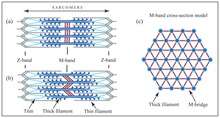Myomesin
Myomesin is an end line protein that is part of the M line. It is a protein found in the M-band of muscle sarcomeres in association with M-protein.[1] It is found in both slow and fast muscle fibers while M-protein is only found in fast fibers.[2] These proteins are thought to be involved in anchoring the thick filaments of the sarcomere (myosin) to other filaments, namely titin, stabilizing and aligning the structure.[3] It may function as a molecular spring that protects the sarcomere and keeps it stable during intense or sustained stretching.[4] While its specific function is still not completely understood, it has been shown that it is closely associated with myosin as it is present in all skeletal and cardiac muscle from the earliest stages of muscle tissue formation.

In Humans, myomesin is encoded by the genes MYOM1 and MYOM2.
References
- Tskhovrebova, Larissa; Trinick, John (2012). "Making muscle elastic: the structural basis of myomesin stretching". PLoS Biology. 10 (2): e1001264. doi:10.1371/journal.pbio.1001264. PMC 3279349. PMID 22347814.
- Daniel Auerbach; Stefan Bantle; Stefan Keller; Vera Hinderling; Martin Leu; Elisabeth Ehler; Jean-Claude Perriard (1999). "Different domains of the M-band protein myomesin are involved in myosin binding and M-band targeting". Molecular Biology of the Cell. 10 (5): 1297–1308. doi:10.1091/mbc.10.5.1297. PMC 25262. PMID 10233145.
- "Muscle Proteins". Ohio State University. Archived from the original on July 10, 2012. Retrieved December 9, 2010.
- Roman Schoenauer; Patricia Bertoncini; Gia Machaidze; Ueli Aebi; Jean-Claude Perriard; Martin Hegner; Irina Agarkova (2005). "Myomesin is a molecular spring with adaptable elasticity" (PDF). Journal of Molecular Biology. 349 (2): 367–379. doi:10.1016/j.jmb.2005.03.055. PMID 15890201.